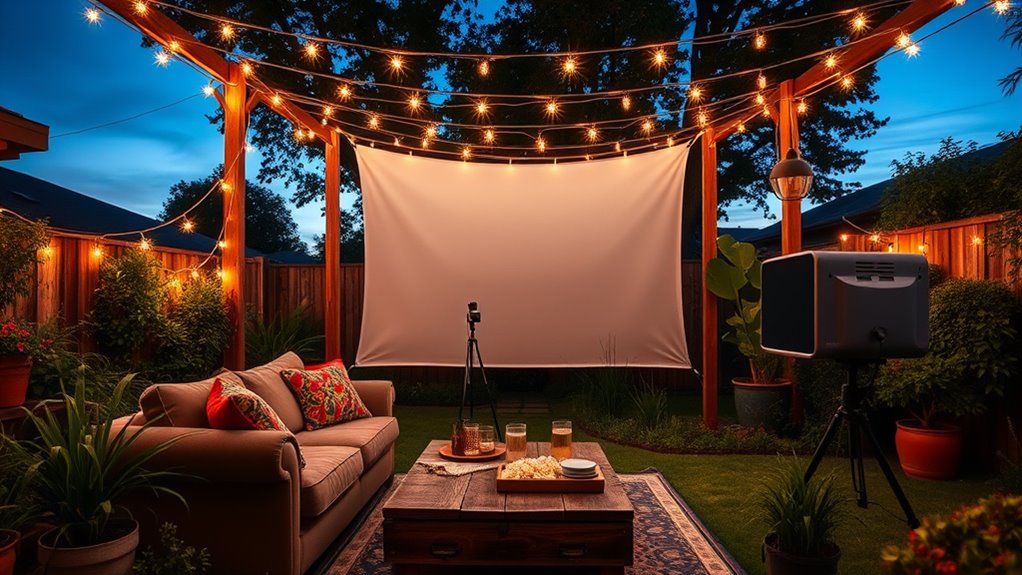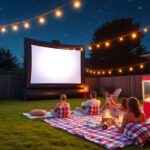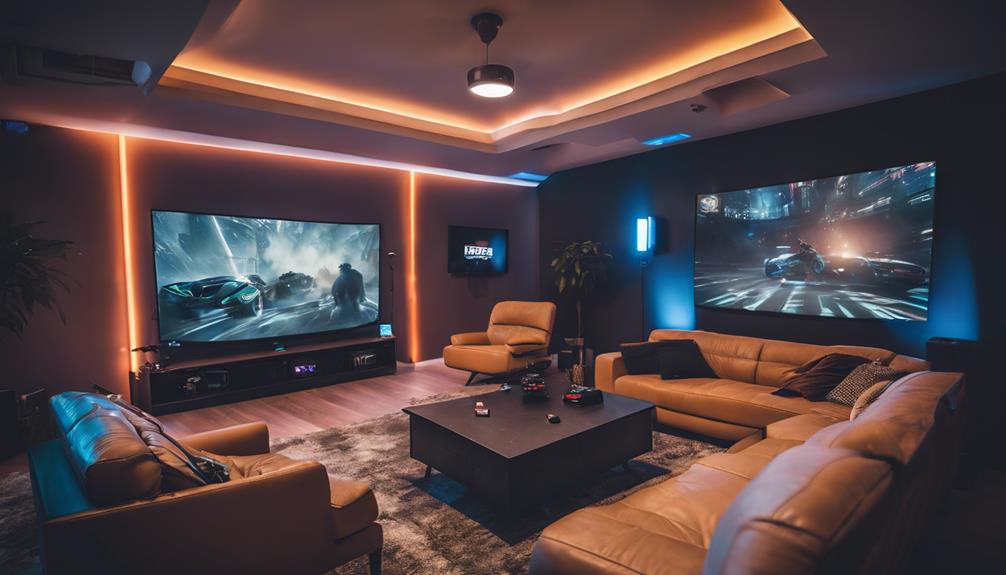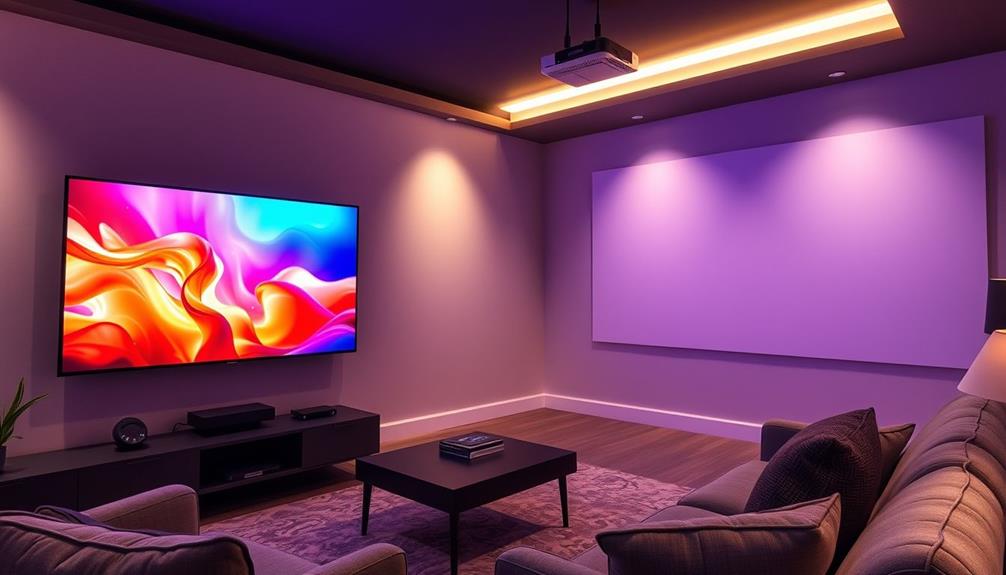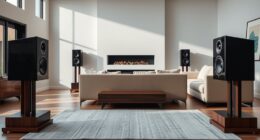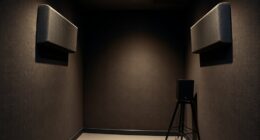To set up an outdoor home theater, pick a flat, dark spot away from lights and noise. Set up a projector with a bright lamp and create a smooth screen using a white sheet or specialized paint. Position weatherproof speakers on either side of the screen and connect your media source. Protect everything from weather with waterproof covers, and run outdoor cords safely. For more tips on perfecting your backyard movie nights, keep exploring the essentials.
Key Takeaways
- Select a flat, unobstructed outdoor area away from lights and noise for optimal viewing conditions.
- Set up a bright projector on a stable surface and create a smooth, light-colored screen surface.
- Arrange weatherproof outdoor speakers on either side of the screen for balanced, clear audio.
- Use waterproof extension cords and covers to protect electronic equipment from weather elements.
- Connect media sources, dim ambient lighting, and add cozy elements like string lights for ambiance.
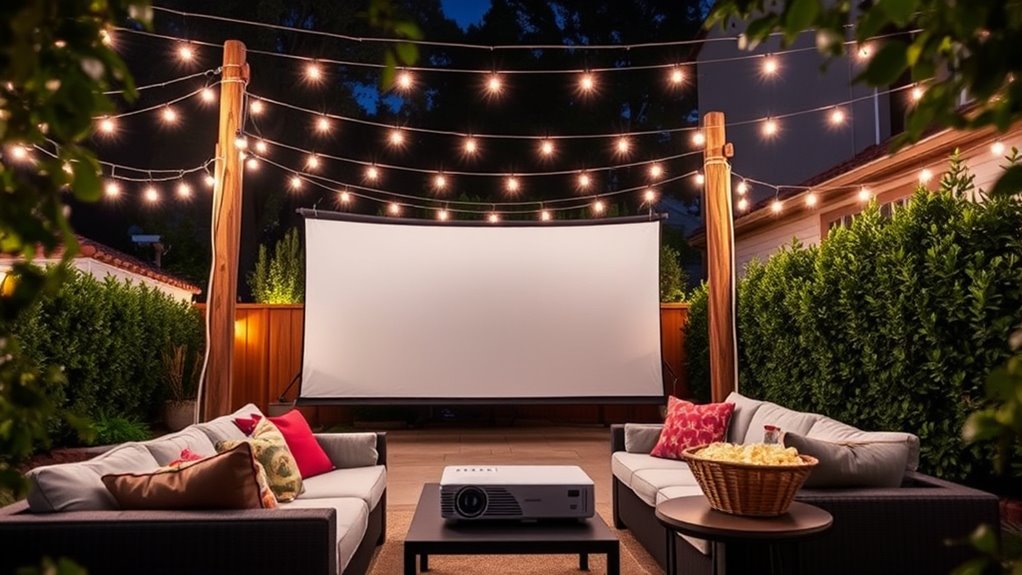
Creating an outdoor home theater transforms your backyard into a personal entertainment oasis, perfect for movie nights under the stars. To get started, you’ll need to choose the right spot—preferably a flat, open area away from streetlights and ambient noise. Clear the space of any debris or obstacles, and consider setting up a level surface or a sturdy platform to guarantee your equipment stays stable and safe. Once you’ve selected the location, think about seating options that suit your space and style, whether it’s outdoor couches, bean bags, or simple foldable chairs. Comfort matters, so plan for enough seating to accommodate your usual crowd.
Transform your backyard into a cozy outdoor theater with a flat, open space away from lights and noise.
Next, you’ll want to focus on your display. A projector is the centerpiece of your outdoor theater, so pick one with sufficient brightness—aim for at least 2,000 lumens to assure a clear image even in some ambient light. Mount the projector on a stable surface or install it on a dedicated pole or ceiling mount if possible, making sure it’s at the right distance from your screen area to produce a sharp image. For the screen itself, you can go with a dedicated outdoor projector screen or create a DIY solution by hanging a white sheet or using a large, flat surface painted with special projector paint. The key is that the surface should be smooth, light-colored, and free of wrinkles. A high contrast ratio will also help improve the clarity and depth of the projected images, especially in darker scenes.
Sound is just as important as the picture, so invest in weatherproof outdoor speakers. Position them on either side of the screen for balanced audio, and test the sound levels beforehand to avoid distortion or volume issues. To prevent weather damage, use waterproof covers or place the speakers under sheltered areas. Also, consider running outdoor extension cords from your power source to your projector and speakers, ensuring all connections are waterproof and safe from the elements. Incorporating wireless audio solutions can also help reduce cable clutter and enhance flexibility. Additionally, selecting equipment compatible with Kia Tuning components can sometimes improve the overall system performance through advanced audio and display options. Remember to keep weatherproofing in mind when designing your setup to ensure durability and safety over time.
Furthermore, staying informed about the latest outdoor entertainment technology can help you upgrade your setup over time and enjoy the best possible experience. Finally, set up your media source, whether it’s a streaming device, laptop, or Blu-ray player. Connect it to your projector and sound system, and test everything before your first movie night. Dimming or turning off ambient lighting makes a noticeable difference, so consider adding string lights or lanterns for a cozy atmosphere without washing out your screen. For optimal viewing, choosing the right screen size and placement is crucial to ensure everyone has a good perspective. With everything in place, you’re ready to enjoy memorable backyard movie nights. Creating an outdoor home theater is about combining the right equipment, thoughtful placement, and ambiance—making your backyard the perfect spot to unwind and enjoy films under the open sky.
Frequently Asked Questions
How Do I Prevent Bugs From Disrupting Movie Nights?
To prevent bugs from disrupting your movie nights, start by choosing a location away from standing water and dense foliage where bugs gather. Use citronella candles, bug zappers, or insect-repellent lights around your setup to deter pests. Keep food covered and clean up crumbs promptly. You can also consider installing a screened enclosure or using insect-repellent sprays that are safe for outdoor use to enjoy uninterrupted movie nights.
What’s the Best Way to Store Outdoor Equipment During Off-Seasons?
Imagine storing your outdoor theater equipment in a waterproof, ventilated shed during winter. To keep everything in top shape, you should clean and dry your devices first. Use protective covers for electronics and consider placing silica gel packs inside storage containers to prevent moisture buildup. Regularly check your gear during off-seasons and store cables neatly coiled to avoid damage. This guarantees your equipment stays ready for your next backyard movie night.
How Can I Ensure Wi-Fi Connectivity Reaches My Backyard?
To make certain your Wi-Fi reaches your backyard, start by placing your router in a central, open spot away from thick walls and metal objects. You can also extend coverage with outdoor Wi-Fi extenders or mesh networks. Position antennas properly, and consider adding a weatherproof access point if needed. Regularly test your connection, and adjust the placement of extenders to boost signal strength for seamless streaming during movie nights.
What Safety Precautions Should I Consider for Outdoor Electrical Setups?
Back in the day, safety was as simple as turning off the lights before bed. Today, with outdoor electrical setups, you should verify all wiring is weatherproof and elevated off the ground to prevent water contact. Use ground-fault circuit interrupters (GFCIs), secure cords to avoid tripping hazards, and keep all connections away from puddles. Regularly inspect your setup for damage, and consider consulting a professional for complex installations.
How Do I Maintain Projector Performance in Varying Weather Conditions?
You should regularly clean your projector’s lens and filters to guarantee clear images, especially after exposure to dust or moisture. Use a weatherproof cover when not in use to protect it from rain, humidity, or dew. Position the projector in a shaded area to prevent overheating and avoid direct sunlight. Also, consider using a dehumidifier or silica gel packs indoors to reduce moisture buildup, maintaining ideal projector performance regardless of weather variations.
Conclusion
Now that you’ve mastered the art of outdoor movie magic, get ready for the ultimate backyard brag. Just remember, no matter how cinematic your setup looks, it’s still just you, your snacks, and a bunch of confused neighbors wondering if you’re launching a drive-in or just testing the neighbors’ patience. So sit back, press play, and enjoy your backyard blockbuster—because nothing says “luxury” like watching movies under the stars… and dodging the lawn sprinkler.
